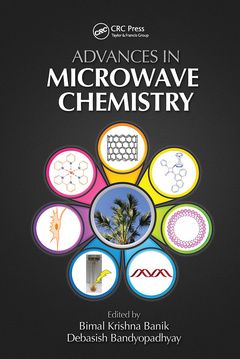Description
Advances in Microwave Chemistry
New Directions in Organic & Biological Chemistry Series
Coordinators: Banik Bimal K, Bandyopadhyay Debasish
Language: English
Subject for Advances in Microwave Chemistry:
Keywords
MW Irradiation; Solvent Free Microwave Conditions; Microwave-accelerated synthesis; Solvent Free Conditions; Heterocycles; Microwave Heating; Carbon-phosphorous compounds; Asymmetric Allylic Alkylation; Thin film photovoltaic applications; Lipozyme TL IM; Synergistic effect of microwaves with other entities; American Chemical Society; David E; Q; Jimenez; Conventional Heating; Lucas Lima Zanin; Focused Microwave Oven; Irlon M; Ferreira; Headspace Single Drop Microextraction; Yara J; K; Araújo; Ionic Liquid; André L; M; Porto; Microwave Synthesis; Mnica B; Alvarez; MAOS; Anabela Lorenzetti; Kabachnik Fields Reaction; Carolina C; Acebal; Sample Preparation; Adriana G; Lista; Microwave Irradiation Conditions; Claudia E; Domini; Lipozyme RM IM; Natalia A; Gomez; Catalyst Free Synthesis; Maite V; Aguinaga; Dialkyl Phosphites; Natalia Llamas; Mad Procedure; Mariano Garrido; Diethyl Phosphite; Carolina Acebal; Aza Michael Reaction; Claudia Domini; Bronsted Acid Catalyst; Lei Wang; Microwave Route; Shengliang Zhong; Phosphine Oxides; Neha Batra; Rahul Panwar; Ramendra Pratap; Mahendra Nath; Jiaxi Xu; Goutam Brahmachari; Raghunan Seelaboyina; Manoj Kumar; Kulvir Singh; Dipti Shukla; Priyank Purohit; Asit K; Chakraborti; Dr; Debasish Bandyopadhyay; Bimal Krishna Banik; Biswa Mohan Sahoo; Jnyanaranjan Pa
Publication date: 06-2021
· 15.6x23.4 cm · Paperback
Publication date: 12-2018
· 15.6x23.4 cm · Hardback
Description
/li>Contents
/li>Biography
/li>
Advances in Microwave Chemistry discusses the novel bond formation methodologies, synergistic effects of microwaves with other entities, sample preparation including digestion, combustion, and extraction techniques, as well as selectivity in chemical processes. Recent updates are provided on microwave-assisted syntheses of pharmacologically significant aza-, oxo- and other heterocycles, including lactams, nucleosides, bile acids and sterols, the preparation of nanomaterials, composites, and absorber layer materials for thin film.
This book also incorporates comparative discussions involving microwave irradiation with conventional methods in different aspects of organic, inorganic, medicinal, and green chemistry.
Key Features:
Microwave-accelerated synthesis and functionalization of diverse oxygen containing six membered heterocycles. Microwaveassisted synthesis of pyrimidine and purine nucleosides as antimetabolites. Recent applications of microwave radiation in biocatalysis. Selectivities in the microwave-assisted organic reactions. Microwave-mediated transition metal-catalyzed synthesis of pharmaceutically important Heterocycles. Microwave-assisted sample preparation. Microwave-induce preparation and application of functional rare earth (RE)-based micro/nanomaterials. Microwave-induced reactions on structurally complex bile acids and sterols. Microwave induced synthesis of carbon-phosphorous compounds. Microwave-induced synthesis of absorber layer materials for thin film photovoltaic application.
Dr. Bimal K. Banik is the Vice President of Research and Education Development of Community Health Systems of South Texas. He was a Tenured Full Professor and First President’s Endowed Professor at the University of Texas-Pan American and an Assistant Professor of University of Texas M. D. Anderson Cancer Center for many years.
He was awarded Bachelor of Science Honors Degree in Chemistry from Itachuna Bejoy Narayan College and Master of Science Degree in Chemistry from Burdwan University. He obtained his Ph. D. degree based upon his thesis work performed at the Indian Association for the Cultivation of Science, Jadavpur.
Dr. Banik was a Postdoctoral Fellow at Case Western Reserve University (Ohio) and Stevens Institute of Technology (New Jersey). He is a Fellow (FRSC) and Chartered Chemist (CChem) of the Royal Society of Chemistry.Dr. Banik has been involved in organic, medicinal chemistry and biomedical research for many years. As Principal Investigator, he has been awarded $7.25 million USD grants from National Institutes of Health, National Cancer Institute, Kleberg Foundation, University of Texas M. D. Anderson Cancer Center, University of Texas-health Science Center and University of Texas-Pan American (UTPA).
Debasish Bandyopadhyay studied chemistry at the Chandernagore Government College and the University of Burdwan (India). He received his Ph.D. in 2004 from the University of Calcutta (India), the oldest university in the South-East Asia.
He performed his first postdoctoral research at the same university with Professor Asima Chatterjee and Professor Julie Banerji. In 2007, he joined at the University of Texas-Pan American as a NIH/NCI postdoctoral fellow with Professor Bimal K. Banik in the Department of Chemistry. In 2011, he was appointed as Assistant Professor of Research in the same department.
His research foci include, but are not limited to, development of greener methodologies aiming to the synthesis of




